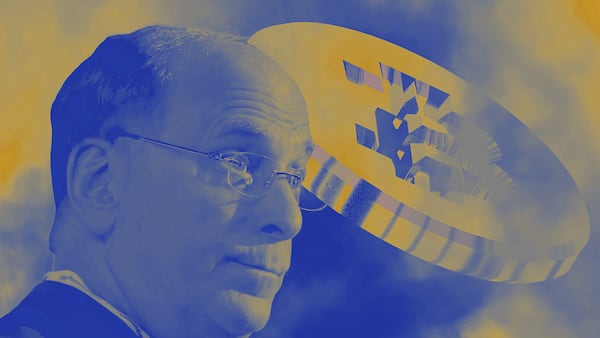- B2C2 CEO Nicola White, a former Citadel Securities exec, says TradFi’s foray into crypto could bring huge capital inflows.
- But financial powerhouses need guardrails to play in volatile markets and to learn from TradFi’s mistakes, she said.
Years rife with scandals and crashed companies have brought a regulatory crackdown on crypto companies that’s left institutional investors desperate for proper guardrails to insulate them from future failures.
Nicola White, the CEO of crypto liquidity provider B2C2, thinks her firm could provide some of those safeguards.
“We want to be the adult in the room,” White told DL News. “Our management team, including myself — most of our experience is in traditional finance. How do we apply that to the exciting and innovative crypto space in a way that works for crypto?”
For her, the value of crypto is less about currency speculation, and more about how the technology can be applied to streamline traditional markets — such as reducing settlement times.
As the industry matures, White said, she hopes the regulatory discussion will swing from talking about “the latest coin” to how to “put corporate or US government bonds on a blockchain and have transparency into who’s doing what and how they’re being traded.”
Her hopes are grounded in fact. Crypto is buzzing from the so-called BlackRock effect — shorthand for the optimism the asset manager injected into the market when it applied for permission to offer a spot Bitcoin exchange-traded fund earlier this year.
NOW READ: BlackRock’s aim to make crypto cheaper should scare Coinbase
But this incursion has been cautious. While BlackRock and other TradFi titans have dabbled in crypto for years, they are leery of the risks — such as wild price swings, a lack of trustworthy intermediaries, and proper anti-money laundering provisions.
“All I know is, we go to jail if we don’t know who we’re trading with,” Joseph Chalom, BlackRock’s head of strategic ecosystem partnerships, said at a Coinbase crypto summit in June.
Market structure firms like B2C2 can alleviate some trepidation by intermediating between their clients and trusted exchanges, offering a service tailored to institutional needs.
B2C2 provides clients with electronic access to about 30 coins on around 20 exchanges, and bilaterally settles the trades — ensuring buyers get their assets and sellers get paid.
NOW READ: It’s not just Bitcoin. These finance giants are ‘chomping at the bit’ to deploy DeFi
The firm’s clientele include crypto-native investment firms, but is also starting to see growing interest from fund managers. Of client onboardings currently in progress, 40% are TradFi, White said.
“We see most of the large asset managers have plans to launch before the end of the year, subject to onboarding,” she said, saying they often start with Bitcoin and Ether, and add “additional coins once they get comfortable with that space.”
Traditional roots
White’s own roots are in TradFi. She joined global bank Morgan Stanley in 2002 through an internship, and went on to write real-time pricing software for the bank’s mortgage-backed bond business.
Later, as global head of rates for the bank’s electronic markets division, White led a major initiative to automate bond trading.
NOW READ: Crypto exchange guardrails are coming whether Gary Gensler wins his crusade or not
In 2016, White joined market maker Citadel Securities as global chief operating officer, again breaking ground in automating rates trading.
Looking for fresh challenges, White joined B2C2 as president of its Americas office in 2021 and became CEO in May 2022.
Benefits of blockchain
From a market structure perspective, crypto has decided advantages over TradFi, White said.
First, blockchain’s transparency provides a visibility into B2C2′s exchange partners that’s unheard of in TradFi.
‘We have real-time visibility into all the major exchanges that we trade on/
— Nicola White
“We have real-time visibility into all the major exchanges that we trade on,” White said. “We’re monitoring their wallets in real time, we have automated alerts that let us know if there is a big withdrawal or if there’s something happening in a specific coin.”
B2C2 uses tools like Chainalysis and Elliptic to track who clients interact with, and what they hold in real time.
‘Coming from a world of T+2, 15 minutes is pretty darn good.’
— Nicola White
Settlement, too, is a different ballgame. In TradFi, settlement takes two days after trades are agreed, a lag known as T+2. Blockchain is much vaunted as providing near instant settlement.
“We’re not at instantaneous settlement yet, but coming from a world of T+2, 15 minutes is pretty darn good,” White said.
Adult in the room
Crypto is still in its infancy, learning lessons that TradFi resolved decades ago.
The FTX collapse, for instance, provided an object lesson in why stock exchanges aren’t allowed to hold customer assets — one that stock markets learned 90 years ago from the crash of 1929.
White has had a front row seat to many of these painful lessons. She watched the credit crisis unfold from the bond desks of Morgan Stanley in 2007.
She also recalled the Swiss central bank’s surprise 2015 decision to depeg its currency from the Euro, causing wild swings in the price of the Swiss franc that put many investors out of business.
That kind of shock event has inspired traditional exchanges to introduce measures that protect investors when unusual volatility hits.
NOW READ: Government clampdown threatens to ‘kill’ crypto industry, Blockchain Australia CEO warns
Often these measures are imposed by regulators. The US Securities and Exchange Commission, for instance, demands that stock exchanges implement circuit breakers — they must stop trading when pricing indexes hit certain levels.
But those safeguards don’t exist as consistently across crypto exchanges, forcing B2C2 “to be careful with our integration to them,” White said.
The perceived lack of control means B2C2 may not make orders, but only take liquidity at those exchanges, White said.
Real inflows
For industry purists, measures like these are antithetical to crypto’s entire point — the decentralisation and disintermediation of financial markets.
But for White, it’s not about shoehorning crypto into TradFi market structure, but applying TradFi’s painful lessons to make crypto fit for purpose.
It’s only with strong institutional participation that crypto will see real inflows of capital and liquidity, as that will make retail customers become more comfortable with investing.
That’s the exciting proposition of a BlackRock Bitcoin ETF. If investors can access a crypto ETF through their Fidelity or Robinhood account, that lowers the barrier to entry.
NOW READ: Fidelity races BlackRock to a Bitcoin ETF — but Cathie Wood’s Ark is first in line
Average daily trading volumes for US ETFs hit $141.6 billion in the second quarter of 2023, White said.
“Think about if a small portion of that moves over to crypto,” she added.
Do you have a tip on B2C2, BlackRock or another story, reach out to me at joanna@dlnews.com.



